MOST people probably know many things about the Land Down Under, but if it happens that it’s only one or two things, likely these include the tale of how, when the British began colonizing Australia’s eastern shores in the late 1800s, boatloads of jailbirds were involuntarily hauled in tow. Prison wards in England were crammed full, dark and tight (just read Dickens’ Little Dorrit); offloading convicts to the colonies was one way to relieve overcrowding. Many of those forcibly resettled unfortunates had been found guilty only of minor crimes — forging checks, unpaid debts, that sort of thing. Others had committed worse. Either way, once they’d served out their sentences, many stayed.

Old Melbourne Gaol, 1838-1845
From this single, oft-tapped historical spigot of a fact, a fountain of cultural stereotypes continues to gush. Such as: Australian bodies, especially male bodies, come blonde, big-boned, and saturated with unusually high alcohol content. Australian social practices tend toward the big-hearted and ever-so-slightly crass. Australians incline toward the provincial; inward-looking, they can be a bit quizzical if not suspicious about the pertinence to them and theirs of knowledge harking from beyond their continent’s shores.
Time to shut that spigot off for good. It’s all nonsense. (Indeed so much so that I predict that Danny will object to my writing the paragraphs above, maintaining that one shouldn’t risk perpetuating untruths by recyling them, even if only to discount their veracity.) Since 1996, year after year, the largest percentage of immigrants settling here hail from South and East Asia (you can see the statistics here: http://www.homeaffairs.gov.au/about/reports-publications/research-statistics/statistics/live-in-australia/historical-migration-statistics). And though it’s true that around 20% of Australians claim a convict in their ancestry, that means 80% don’t — and one distant convict in one’s otherwise full ancestral tree is hardly a mark of Cain. Besides, what does it matter? The last flotilla of villainy landed here in 1868, 160 years and many generations ago.
Nonetheless, architectural artifacts of the country’s penal heritage constitute its earliest landmarks. Some, as in Sydney, are buried beneath later infrastructure near the shoreline (near the Barangaroo Reserve in Sydney, below); others, like the splendid, if forbidding Old Melbourne Gaol (above), are historic monuments.

Barangaroo Reserve, Sydney
Today, these are but tiny, obdurate reminders of Australia’s early history, buried in the urban fabric of its cities. So what can we say, even provisionally, about Australian urbanism given our scant exposure to Sydney and Melbourne?
Sydney and Melbourne’s sites differ, for sure. Hilly Sydney boasts of its fun-in-the-sun, 150 decadent miles of shoreline, and that’s not even counting ever-hungrily-land-sucking suburbs. Melbourne’s largely undifferentiated flatlands are slung lazily along the muddy, unprepossessing Yarra River. Even so, their patterns of urban development and growth vary less, or so it seemed to me. And if Sydney and Melbourne’s urbanism represents any sort of larger reality (I wager they do), then Australians have by and large embraced, and more or less consistently practiced admirable social democratic ideals: what we saw evinced a well-considered, well-constructed, well-ordered civil society, even with predictable infelicities of all sorts notwithstanding. We saw this in the residential areas and in the city’s newer public spaces, the topic of the next post.
WE situated ourselves in the so-called “inner ring” suburbs, which seems to denote a distance from the urban core of approximately 4-5 kilometers. Our first stop in Melbourne was tiny Middle Park (population ca. 4000), conveniently proximate both to the City Center and the Pacific Ocean. The neighborhood retains an impressive stock of diminuitive Victorian residences (many with ornate cast iron porch details, as below), most in reasonably good repair. 
Scattered around, tucked between the older homes, are a number of modern single-family dwellings. It’s one of the better ones of these newer places that we managed to score. Tiny: two bedrooms upstairs; kitchen, living and dining room down. A nice patio in back, though.


 The recessed light well, at right, broke up the linearity of the main living area and admitted all manner of light and weather, including the torrential rains with which we were greeted –four seasons in a day, Uber drivers told us again and again, pontificating about the city’s fickle weather. Anyway, our little Middle Park abode proved a hospitable place to enjoy even the downpours, presenting them artfully, at a slight remove.
The recessed light well, at right, broke up the linearity of the main living area and admitted all manner of light and weather, including the torrential rains with which we were greeted –four seasons in a day, Uber drivers told us again and again, pontificating about the city’s fickle weather. Anyway, our little Middle Park abode proved a hospitable place to enjoy even the downpours, presenting them artfully, at a slight remove.
Itinerants we are, ever subject to the booking impulses of Airbnb’ers the world over as well as our own changing needs, we had to move after a fistful of days. We landed in a that-much-smaller place, an apartment in a residential high-rise in South Yarra, a decidedly more upscale, far denser district (population ca. 25,000), although its distance from the city center equivalent to that of Middle Park. From there, we got to survey Melbourne’s horizontal and vertical spread.
 Scattered hillocks of towers, residential and commercial, pop up from the lilyponds of two-to-four story mixed-use buildings which spread in nearly every direction, all the way to the horizon.
Scattered hillocks of towers, residential and commercial, pop up from the lilyponds of two-to-four story mixed-use buildings which spread in nearly every direction, all the way to the horizon. In commerical and higher-density residential neighborhoods, the taller structures indicate that Melbourne, like Sydney, takes its towers seriously.
In commerical and higher-density residential neighborhoods, the taller structures indicate that Melbourne, like Sydney, takes its towers seriously.

New ones, and old ones, too.

In any case, in both cities, it seems that they’re erecting a lot more of them.  I tried to discover statistics on new residential and office space real estate, but curiosity vanished in the deluge of Google hits beckoning me to bankers’ and developers’ websites, so I’ll just go with the information offered by Meaghan Dwyer of John Wardle Architects: in both cities, there’s a lot of building going on.
I tried to discover statistics on new residential and office space real estate, but curiosity vanished in the deluge of Google hits beckoning me to bankers’ and developers’ websites, so I’ll just go with the information offered by Meaghan Dwyer of John Wardle Architects: in both cities, there’s a lot of building going on.
Much of it good, and good in ways that indicate a heartening — or shall I say big-hearted?– vision of a social realm that supports sociability for all city-dwellers, not just the wildly privileged. 
For notable public spaces and landscapes in both cities and what they might mean, stay tuned.
— Sarah






 Then we practically ran straight into one of the best Hans (aka Jean) Arp sculptures, from his “Growth” series, that I’ve ever encountered. I was really tempted to hug it.
Then we practically ran straight into one of the best Hans (aka Jean) Arp sculptures, from his “Growth” series, that I’ve ever encountered. I was really tempted to hug it.




 Since mirrors can be used to visually diminish the scale of the object they reflect, you get to experience the piece both as it envelops you, spreading majestically over your head and bleeding into your peripheral vision, and at the same time, regard its entirety by glancing toward the silvery pools of light near your feet.
Since mirrors can be used to visually diminish the scale of the object they reflect, you get to experience the piece both as it envelops you, spreading majestically over your head and bleeding into your peripheral vision, and at the same time, regard its entirety by glancing toward the silvery pools of light near your feet.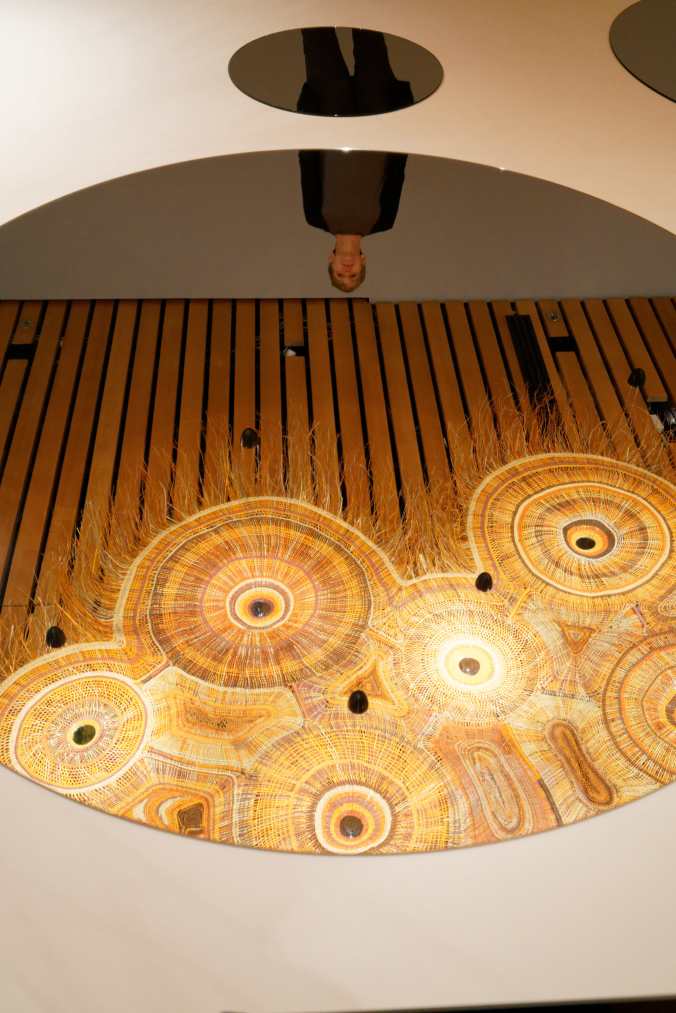

 and others masonry. A few of these areas snuggle up to, or surround a little open area akin to a village green– below, look how some kid just dropped her bicycle and walked in her front door with no thought of locks or bike stands. Just as we all used to do, growing up. Right in the middle of Sydney!
and others masonry. A few of these areas snuggle up to, or surround a little open area akin to a village green– below, look how some kid just dropped her bicycle and walked in her front door with no thought of locks or bike stands. Just as we all used to do, growing up. Right in the middle of Sydney! Nearby stood larger buildings that served the original community — perhaps a library, a school, a church. What the building below was or now is remains a mystery, but it’s fairly typical of the small Victorian public infrastructure in both Sydney and Melbourne.
Nearby stood larger buildings that served the original community — perhaps a library, a school, a church. What the building below was or now is remains a mystery, but it’s fairly typical of the small Victorian public infrastructure in both Sydney and Melbourne.


 That red-brick/yellow-ochre detailing is a common combination in public buildings in both cities.
That red-brick/yellow-ochre detailing is a common combination in public buildings in both cities.











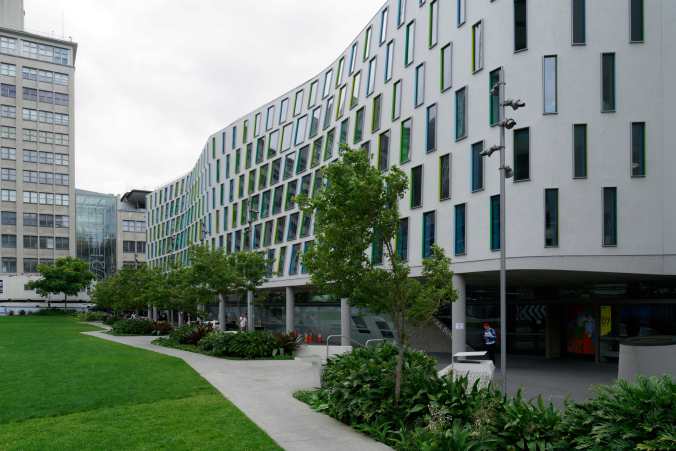


 We departed Sydney ahead of schedule, after but a few days, to a recuperative place, Palm Beach, an hour north, where the din (noise bothered him) and bustle of the city were replaced by the quietude and seaside rhythms of nature.
We departed Sydney ahead of schedule, after but a few days, to a recuperative place, Palm Beach, an hour north, where the din (noise bothered him) and bustle of the city were replaced by the quietude and seaside rhythms of nature. 
 The most obtrusive sounds came from the many birds flying around, especially in the early morning, with some (most notably, a faithful white cockatoo with a yellow crest), to our thrill, visiting our veranda. Gideon loved our place there and what constituted the thereness of there.
The most obtrusive sounds came from the many birds flying around, especially in the early morning, with some (most notably, a faithful white cockatoo with a yellow crest), to our thrill, visiting our veranda. Gideon loved our place there and what constituted the thereness of there.

 explored the magnificent Royal Botanic Gardens,
explored the magnificent Royal Botanic Gardens,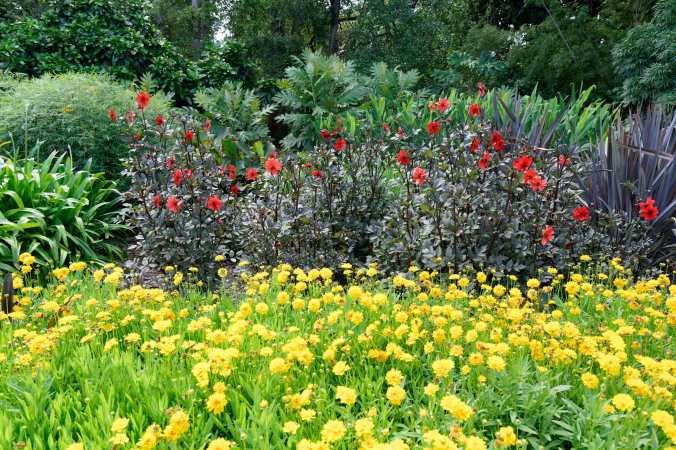
 and walked and looked, which, after all, is just about our favorite urban activity – especially when the walking and looking amply reward.
and walked and looked, which, after all, is just about our favorite urban activity – especially when the walking and looking amply reward.

 To give Queenstown its due, it is perhaps the most beautiful and monumental setting of any urban area (it’s a small one) we have seen.
To give Queenstown its due, it is perhaps the most beautiful and monumental setting of any urban area (it’s a small one) we have seen.
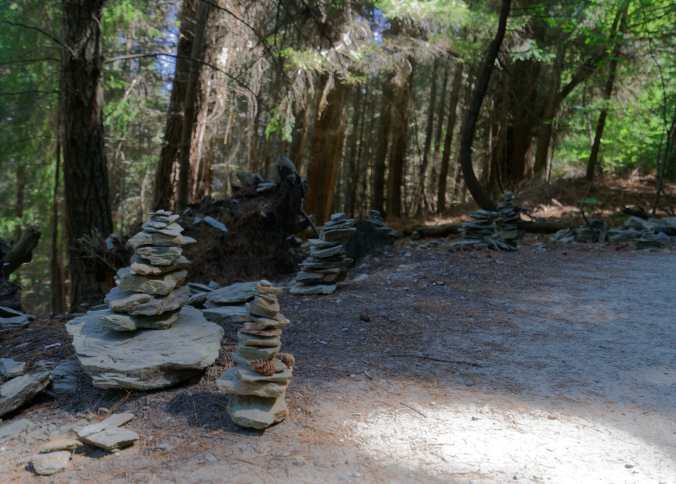
 The landscapes of the region we have justly gushed (never enough) about. Even the humdrum among them – the city park, and an elevation-static walk starting in Queenstown along the lake and then beyond – are memorable and prospectively never tiring. Our one disappointment, not being able to walk/hike the three-day Routeburn Track, reputably among the most exquisite in New Zealand, owing to a minor injury Gideon sustained, turned into a compensatory boon of us getting to explore by car and foot more of the Queenstown region. After leaving the urban and in its own way urbane area of Queenstown, we drove through the seductive temperate rainforest
The landscapes of the region we have justly gushed (never enough) about. Even the humdrum among them – the city park, and an elevation-static walk starting in Queenstown along the lake and then beyond – are memorable and prospectively never tiring. Our one disappointment, not being able to walk/hike the three-day Routeburn Track, reputably among the most exquisite in New Zealand, owing to a minor injury Gideon sustained, turned into a compensatory boon of us getting to explore by car and foot more of the Queenstown region. After leaving the urban and in its own way urbane area of Queenstown, we drove through the seductive temperate rainforest
 and mountainscapes of the west coast, fittingly named West Coast, and then across the mountain isthmus of Arthur’s Pass to a more conventional and more distinctive urban experience of Christchurch.
and mountainscapes of the west coast, fittingly named West Coast, and then across the mountain isthmus of Arthur’s Pass to a more conventional and more distinctive urban experience of Christchurch.




 where we strolled for a few hours thinking of an architecturally unsullied Miami Beach and disputating the desirability of returning to Napier someday for a longer stint, before heading off by car to Tongariro, and its justly famous transalpine tramp. After four days of our rural and hiking wonders of Tongariro
where we strolled for a few hours thinking of an architecturally unsullied Miami Beach and disputating the desirability of returning to Napier someday for a longer stint, before heading off by car to Tongariro, and its justly famous transalpine tramp. After four days of our rural and hiking wonders of Tongariro  (Sarah: “I would do that hike every year”) and Rotorua – both of Hobbit/Lord of the Rings fame – we finished off our New Zealand romp with two solid days in Auckland’s Viaduct area, with a splendid view of the harbor, urbanity, and enough worthy activities to keep us happy.
(Sarah: “I would do that hike every year”) and Rotorua – both of Hobbit/Lord of the Rings fame – we finished off our New Zealand romp with two solid days in Auckland’s Viaduct area, with a splendid view of the harbor, urbanity, and enough worthy activities to keep us happy.




 and in the a Napier museum, receiving the unexpected pleasure of being introduced to a merging of arts we had not imagined in the body (really body-covers) of historic Art Deco
and in the a Napier museum, receiving the unexpected pleasure of being introduced to a merging of arts we had not imagined in the body (really body-covers) of historic Art Deco 
 immersing ourselves in the experience of the most magnificent landscapes of nature’s pacific and tumultuous offerings, getting a taste or more of the largest (Auckland, 1.5M), third largest (Christchurch, 400K), sixth largest (Napier, 130K), tenth largest (Rotorua, 60K), and barely-large-enough-to-be-one, placing 27th (Queenstown, 15K) city, and many larger and smaller towns in-between, and taking pleasure in some of the finer products of human creativity. Everywhere and without exception, the New Zealanders were friendly, helpful, informed, and well-spoken in, at least to me, their charmingly accented English. They appear to know that they have something extraordinary going for them,
immersing ourselves in the experience of the most magnificent landscapes of nature’s pacific and tumultuous offerings, getting a taste or more of the largest (Auckland, 1.5M), third largest (Christchurch, 400K), sixth largest (Napier, 130K), tenth largest (Rotorua, 60K), and barely-large-enough-to-be-one, placing 27th (Queenstown, 15K) city, and many larger and smaller towns in-between, and taking pleasure in some of the finer products of human creativity. Everywhere and without exception, the New Zealanders were friendly, helpful, informed, and well-spoken in, at least to me, their charmingly accented English. They appear to know that they have something extraordinary going for them,  and, generous lot that they are — here’s a woman who runs a weekly open-air soup kitchen in Auckland, offering us a meal —
and, generous lot that they are — here’s a woman who runs a weekly open-air soup kitchen in Auckland, offering us a meal —  they don’t mind sharing the natural and urbanistic wealth.
they don’t mind sharing the natural and urbanistic wealth. One place that succeeded in earning a top spot in our greatest hits album (maybe that’s this blog) was in the volcanic Rotorua region, which includes the Tarewera, a volcano that has erupted 5 times in last 18,000 years (one so extreme that it cast volcanic dust as far away as Greenland), as well as the Waimangu. The last major eruption of the volcanic craters all along Waimangu valley was in 1886, which falls easily within the era of photography. The
One place that succeeded in earning a top spot in our greatest hits album (maybe that’s this blog) was in the volcanic Rotorua region, which includes the Tarewera, a volcano that has erupted 5 times in last 18,000 years (one so extreme that it cast volcanic dust as far away as Greenland), as well as the Waimangu. The last major eruption of the volcanic craters all along Waimangu valley was in 1886, which falls easily within the era of photography. The  The Waimangu regaled us with hot waters,
The Waimangu regaled us with hot waters, and hot (and cool, in both senses of the word) colors,
and hot (and cool, in both senses of the word) colors,
 and with a tiny, even cute little geyser (below, at the left side of the image), wholly unlike the more conventional tower of water we saw a few years ago outside of Reykjavik in the gushing font that gave its name to this natural though relatively rare phenomenon, Geysir.
and with a tiny, even cute little geyser (below, at the left side of the image), wholly unlike the more conventional tower of water we saw a few years ago outside of Reykjavik in the gushing font that gave its name to this natural though relatively rare phenomenon, Geysir. 

 that reminded Sarah of one of her newish-ly favorite paintings, by Gustav Klimt, which we saw in an exhibition of landscape art from The Paul G. Allen Family Collection at the Phillips Collection in Washington DC.
that reminded Sarah of one of her newish-ly favorite paintings, by Gustav Klimt, which we saw in an exhibition of landscape art from The Paul G. Allen Family Collection at the Phillips Collection in Washington DC. 
 offering a skylet-high tree walkway,
offering a skylet-high tree walkway,  right outside the city of Rotorua, the forest the result of a tree growing commercial experiment which brought the trees over from California way-back-when-enough that the (skinny) redwoods reach (from unverified memory) three hundred feet and more.
right outside the city of Rotorua, the forest the result of a tree growing commercial experiment which brought the trees over from California way-back-when-enough that the (skinny) redwoods reach (from unverified memory) three hundred feet and more.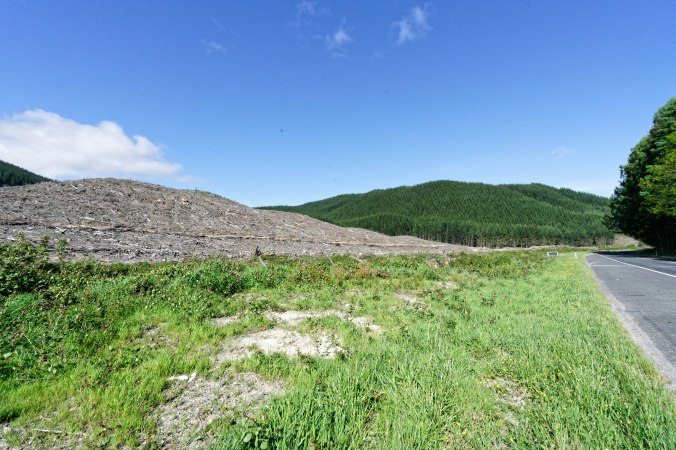
 make Maya Lin’s land-sculpture in Storm King Sculpture Park,
make Maya Lin’s land-sculpture in Storm King Sculpture Park, which we once admired, a bit self-mocking. Driving through hours of such hillocks made for the greenest mad-undulating landscape this side of our known experience.
which we once admired, a bit self-mocking. Driving through hours of such hillocks made for the greenest mad-undulating landscape this side of our known experience. Sarah’s favorite tree — its name escapes us — was that black-barked fern, plentiful in much of New Zealand, which, in rain-forest-y
Sarah’s favorite tree — its name escapes us — was that black-barked fern, plentiful in much of New Zealand, which, in rain-forest-y